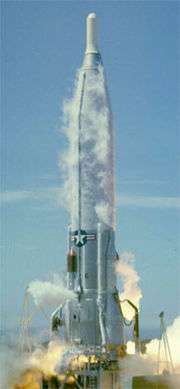GX (rocket)
 GX (Shown with Atlas III first stage as in early development) | |
| Function | Medium expendable Launch vehicle |
|---|---|
| Manufacturer | Galaxy Express (JAXA/ULA/IHI) |
| Country of origin | Japan/United States |
| Size | |
| Height | 48m |
| Diameter | 3.3m |
| Mass | 190,500 kg (210 tons) |
| Stages | 2 |
| Capacity | |
| Payload to LEO | 3,600kg (4 tons) |
| Payload to 800km SSO | 1,814kg (2 tons) |
| Launch history | |
| Status | Cancelled 2010 |
| Launch sites | Vandenberg SLC-3E |
| First stage - Atlas CCB | |
| Engines | 1 RD-180 |
| Thrust | 4,152 kN (933,406 lbf) |
| Specific impulse | 311 sec |
| Burn time | 253 seconds |
| Fuel | RP-1/LOX |
| Second stage - GX | |
| Engines | 1 liquid |
| Thrust | 118 kN |
| Specific impulse | 323 sec |
| Burn time | 480 seconds |
| Fuel | LNG/LOX |
GX was a design for an expendable launch system intended to compete in the commercial satellite launch sector. The system had developed by Galaxy Express Corporation, a joint venture between IHI Corporation (IHI), the Japan Aerospace Exploration Agency (JAXA), United Launch Alliance (ULA), Lockheed Martin Corporation (LM) and several other Japanese companies.[1]
The GX design uses a two-stage rocket. The first stage would have been the Atlas Common Core Booster, currently used as the first stage of the Atlas V rocket, which would have been provided by United Launch Alliance.[2] The second stage was to be a newly designed stage produced by IHI, using liquefied natural gas as fuel and liquid oxygen as an oxidizer. The GX would have been the only space vehicle to use that combination of fuel and oxidizer.
The Japanese government finally abandoned the GX program in December 2009. Galaxy Express disbanded around March 2010.[3][4]
History
The GX program began as an effort to upgrade Japan's J-I rocket, which launched only once. Thus, GX was originally known as J-II, albeit briefly. For a time, the program was termed J1-Upgrade, before finally settling on the current name in January 2003.
JAXA reported that a full-scale second-stage engine had been successfully test-fired in October 2007. JAXA was developing this engine, the responsibility for which was planned to eventually be turned over to the Galaxy Express venture.
In late December 2007, The Yomiuri Shimbun newspaper reported that the GX program was being subjected to a thorough review, mainly because of unexpectedly high additional costs. It also erroneously claimed that ULA partner Lockheed Martin had discontinued production of the first stage engine, thereby requiring a redesign, likely costly, to move to another engine. The paper said that the 15 billion yen that JAXA requested for the GX project was eventually slashed to 5.6 billion yen in the Fiscal 2008 budget.
It was originally designed to use an Atlas III first stage, and to be launched from Tanegashima in Japan, however this was abandoned in 2009 in favour of the CCB configuration.
In May 2008, it was reported that the Space Development Committee, who are overseeing the project, were considering its cancellation. In November 2009, the Japanese Government Administration Reform Committee recommended that funding for the second-stage engine be halted.[5]
In December 2009, Japanese government decided to cancel the GX project.[6] Development of the LNG propulsion system will continue for other projects.
In January 2010, IHI determined to disband Galaxy Express. The dissolution resulted in a one-off accounting loss of 11.3 billion yen.[3][4]
References
- ↑ "Galaxy Express Company Profile". GALEX.
- ↑ "GX Launch Vehicle" (PDF). United Launch Alliance. Retrieved 2009-05-07.
- 1 2 "IHI to liquidate GX rocket venture after govt pullout". iStock Analyst. 2010-01-16. Retrieved 2010-01-31.
- 1 2 "Kyodo economic news summary -6-+". 2010-01-29. Retrieved 2010-01-31.
- ↑ "Japan's GX Rocket Targeted For Cancellation in 2010". Space News. 2009-11-20.
- ↑ "Japan scraps GX rocket development project". iStockAnalyst. 2009-12-16. Retrieved 2009-12-16.
External links
- "Archived copy". Archived from the original on 2005-08-28. Retrieved 2005-08-26.

